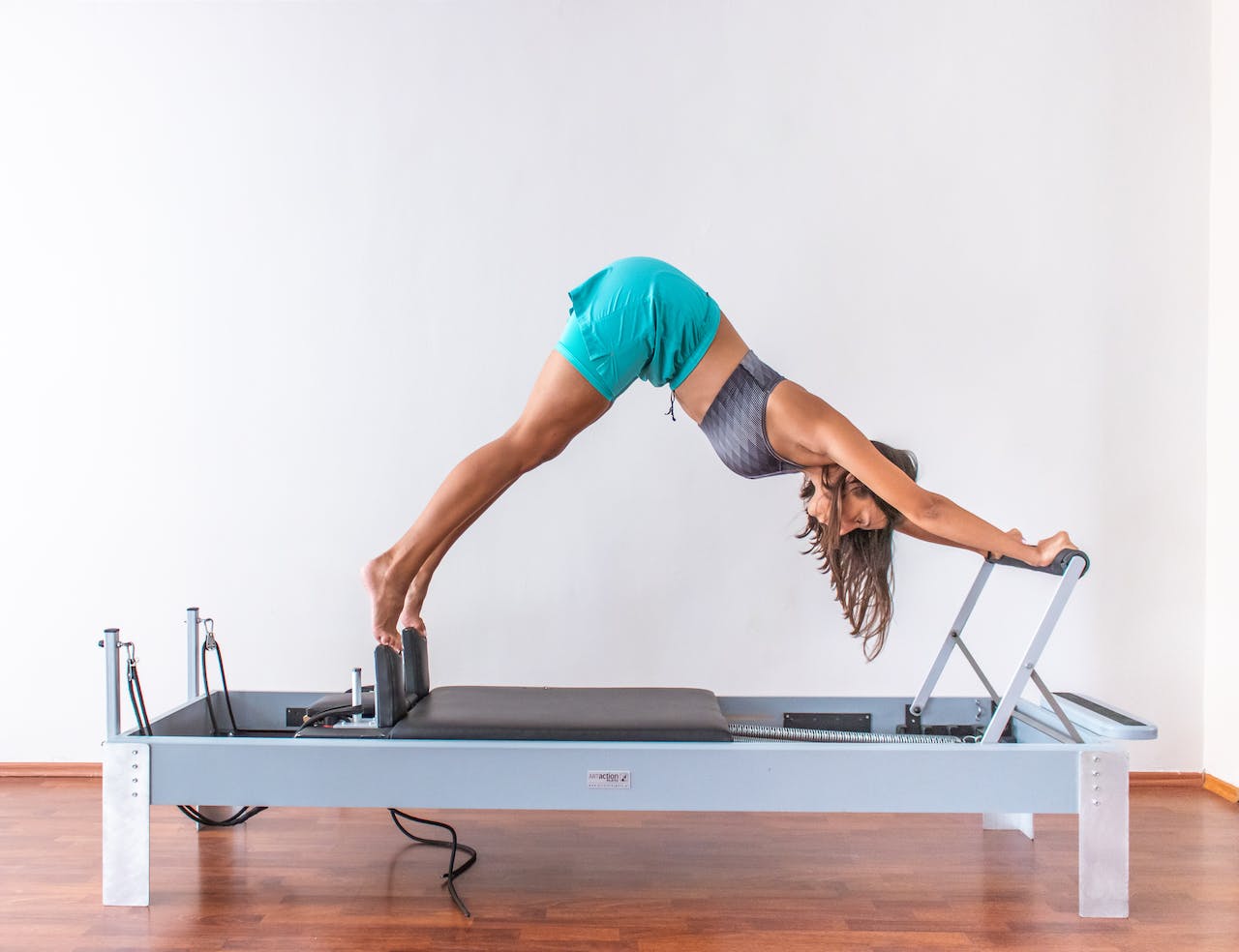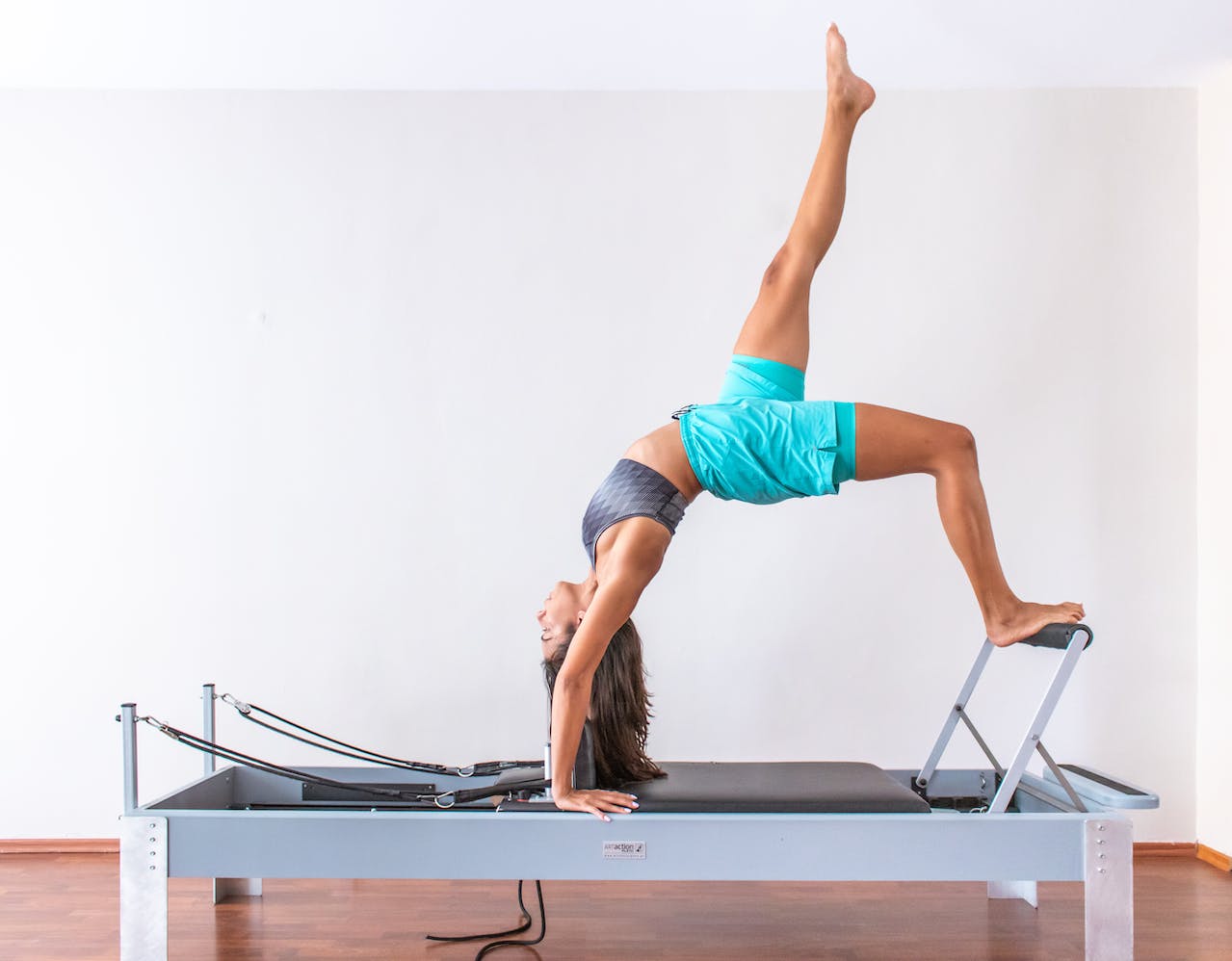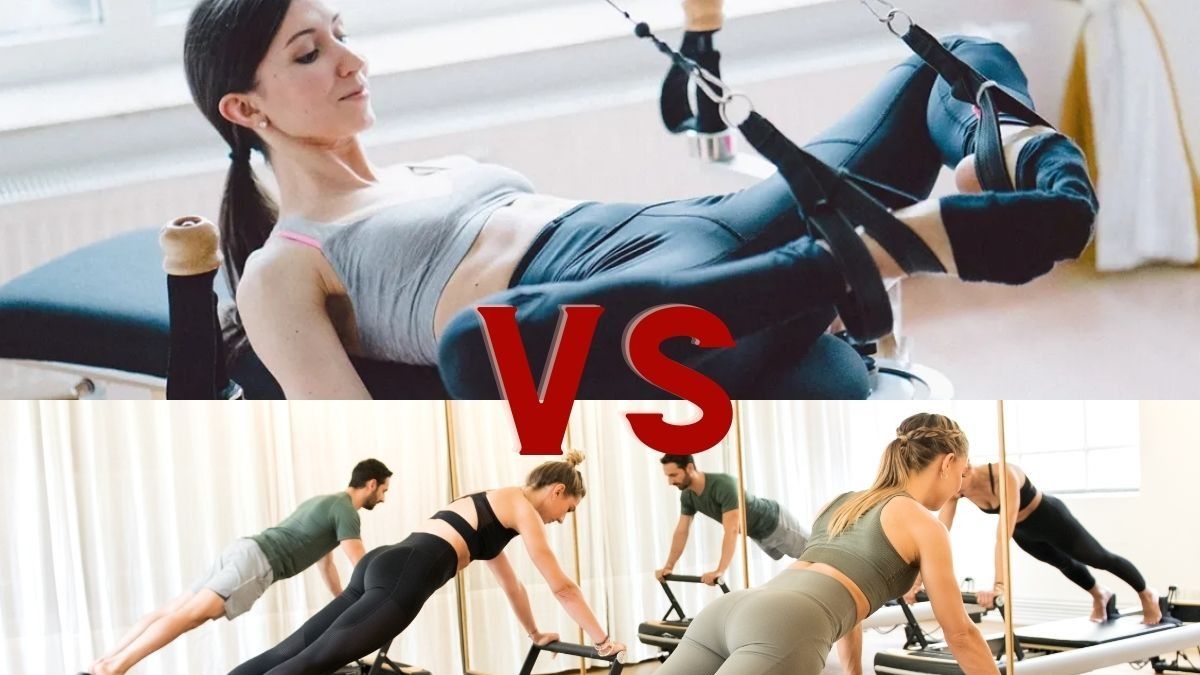What is Reformer Pilates: Exercises & benefits
Reformer Pilates is the Pilates method of movement done on a reformer called the carriage, which rolls back and forth on wheels within the frame.
Have you ever walked by a Pilates studio and seen those intriguing machines that look like a cross between a medieval torture device and a modern gym apparatus? 😂
Those, my friends, are Reformer machines, and they're at the heart of what's known as Reformer Pilates. Now, before you run for the hills, let me assure you, there's nothing scary about them. In fact, they're your ticket to a whole new level of fitness and wellbeing.
Pilates itself has been a buzzword in the fitness community for quite a while, beloved by celebrities and fitness enthusiasts alike. But when you throw a Reformer machine into the mix, things get even more interesting.
Reformer Pilates takes the traditional Pilates experience and cranks it up a notch, offering a unique blend of strength, flexibility, and balance training that's hard to beat.
So, what's the deal with Reformer Pilates, and why should you even care? Well, in this article, we're going to explain and demystify Reformer Pilates, from its fascinating history to the remarkable benefits it offers.
We'll even guide you through some basic exercises to get you started. So, let's explore the world of Reformer Pilates together. And trust us, by the end of this, you'll be itching to give it a try!

Source: Pexels
History and development of Reformer Pilates
The story of Reformer Pilates is a fascinating journey that intertwines human resilience, innovation, and a quest for physical excellence. This transformative fitness method owes its origins to one man's life experiences and his relentless exploration of the human body's potential.
The genesis: Joseph Pilates and his vision
At the heart of Reformer Pilates is its creator, Joseph Pilates. Born near Düsseldorf in 1880, Pilates faced numerous health challenges as a child, including asthma, rickets, and rheumatic fever.
Determined to strengthen his frail body, he delved into various forms of exercise, ranging from Greek and Roman regimens to Eastern practices like yoga and Zen meditation [1].
Pilates' diverse interests and his dedication to understanding the body's mechanics laid the groundwork for his revolutionary fitness philosophy.
Developing the Pilates method
Pilates' journey took a dramatic turn during World War I. Living in England at the outbreak of the war, he was interned as an "enemy alien." It was during this internment that Pilates began shaping his unique approach to exercise and body conditioning.
In a stroke of ingenuity, he used his nursing role to experiment with bed springs, rigging them to hospital beds to help bed-bound patients exercise. This innovation was the precursor to the first Pilates machines, including what we now know as the Reformer [1].
From rehabilitation to a comprehensive fitness system
After the war, Pilates continued refining his methods, collaborating with experts like Rudolf Laban, a movement technique pioneer. Pilates' work in Germany after WWI further cemented his reputation as a trailblazer in physical training [1].
The Reformer: A synthesis of Pilates' vision
The Universal Reformer, as it was initially called, was a manifestation of Pilates' holistic approach to physical training.
This apparatus, equipped with springs, ropes, and pulleys, was designed to offer resistance and support a wide range of exercises targeting different muscle groups. It emphasised controlled, precise movements, reflecting Pilates' belief in the interplay of mental and physical discipline [2].
Pilates in America: Spreading the word
In 1923, Pilates moved to America, opening his first studio in New York with his wife Clara. His method, originally called "Controlology," quickly gained popularity, especially among dancers like Martha Graham and George Balanchine, who found it ideal for injury recovery and prevention [1].
Reformer Pilates: Evolution and adaptation
Over the years, the Reformer has seen numerous iterations and modifications, some deviating from Pilates' original design. These changes have often sparked debate about staying true to Pilates' intent versus adapting to contemporary fitness needs [2].
A global fitness phenomenon
The Pilates method, along with the Reformer, didn't return to Britain until the 1970s, introduced by Alan Herdman.
Since then, it has become a global fitness phenomenon, with studios and practitioners spanning continents, each bringing their unique interpretation to this versatile exercise system [1].
Read more: What is Pilates and top 10 studios in Malaysia that you can try it

Source: Unsplash
Understanding the Reformer machine
When you step into a Pilates studio, the Reformer machine often takes centre stage. At first glance, it might seem intimidating with its array of springs, straps, and a sliding carriage, but don't let its appearance fool you. This machine is a gateway to a transformative workout experience, blending versatility and precision in a way no other Pilates equipment does.
Anatomy of the Reformer
Let's break down the Reformer's key components:
1. The Carriage: This is the heart of the Reformer. It's a flat platform that slides back and forth along the frame of the machine. You'll be lying, sitting, kneeling, or standing on this during various exercises. The carriage is attached to one end of the Reformer by a set of springs, which provide varying levels of resistance.
2. The Springs: Attached to the carriage, these springs are the soul of the Reformer. They can be adjusted to modify resistance, making exercises more or less challenging. This adjustability is crucial, as it allows for a tailored workout suitable for beginners through to advanced practitioners.
3. The Footbar: Positioned at the end of the Reformer, the footbar is used for placing your feet or hands during exercises. It's adjustable, accommodating different sizes and types of movements.
4. The Straps: Attached to the top end of the carriage, these straps can be pulled with hands or feet. They’re integral for exercises targeting arm and leg muscles, bringing a dynamic range to your workout.
5. The Frame and rails: These provide the structure that houses the carriage and guides its smooth movement.
The beauty of the Reformer lies in its versatility. It's designed for a full-body workout, capable of targeting almost every muscle group. The adjustable resistance of the springs means it's as effective for rehabilitating injuries as it is for challenging seasoned athletes.
Enhancing traditional Pilates with the Reformer
The Reformer machine elevates the traditional Pilates experience by introducing a level of versatility and intensity that mat exercises alone can't match. Here's how:
1. Increased resistance and muscle engagement: The springs on the Reformer add adjustable resistance, making exercises more challenging. This not only engages more muscle groups but also deepens the intensity of each movement.
2. Greater range of motion: The sliding carriage allows for a more extensive range of motion, enabling deeper stretches and more complex exercises that are not possible on a mat.
3. Improved precision and control: The structure of the Reformer encourages precision in movement. The need to control the carriage’s movement fosters a heightened awareness of body alignment and control, core engagement, and balance.
4. Adaptability to all levels: Whether you're a beginner or an advanced practitioner, the Reformer can be adjusted to suit your level of fitness and flexibility. This adaptability ensures a consistently challenging workout as you progress.
5. Focus on core stability: Many Reformer exercises require you to stabilise the moving carriage with your core muscles, intensifying the focus on core strength and stability, which is a fundamental aspect of Pilates.
6. Variety and creativity in workouts: The Reformer's design allows for an extensive array of exercises, keeping workouts fresh, challenging, and engaging, which can enhance motivation and enjoyment.

Source: Pexels
Core principles of Reformer Pilates
Reformer Pilates, while retaining the essence of the original Pilates method, brings a unique blend of principles to the fore. These core tenets are not just exercises but philosophies that shape every aspect of Reformer Pilates practice.
1. Breathing techniques
Breathing in Pilates isn't merely a physical function; it's an integral part of the exercise, helping to focus the mind and engage the core.
The technique involves inhaling deeply through the nose, expanding the rib cage, and exhaling forcefully through pursed lips, activating the deep core muscles.
This controlled breathing enhances performance, lung capacity, and brings a sense of relaxation and focus to each session.
2. Concentration
The practice of Reformer Pilates requires a deep connection between mind and body, achievable through intense concentration.
Focusing on each movement ensures correct execution and a deeper understanding of the exercise's impact on the body. This mindfulness allows for a more fulfilling and effective workout, enhancing both mental clarity and physical prowess.
3. Control
Control is central to Pilates. It involves mastering each movement with precision, thereby improving coordination and reducing the risk of injury.
Key to developing control is intentional breathing, starting exercises slowly to master form, and ensuring proper alignment. This principle aids in building overall physical fitness and strength.
4. Centering
Centering, or engaging the 'powerhouse' muscles of the core, is fundamental in Pilates. It's about finding balance and stability, using the core to support all movements.
Proper breathing and alignment are essential in achieving this centering, enhancing strength, flexibility, and self-awareness.
5. Precision
Precision in Pilates is about focusing on the quality of each movement rather than the quantity. It demands precise alignment, activation of specific muscles, and a strong mind-body connection.
This focus on precision ensures effective muscle engagement, better posture, and improved overall health.
6. Fluidity of flow
The principle of flow in Pilates is about seamless transitions between exercises, maintaining a steady rhythm without losing control. This fluidity enhances physical awareness, coordination, and maintains a sense of calm.
It's a graceful execution that emphasizes the harmony between movement and breath, contributing to strength, flexibility, balance, and well-being.

Source: Pexels
Basic Reformer Pilates exercises
Starting with Reformer Pilates can be an exciting journey into a new realm of fitness. For beginners, it's essential to get acquainted with basic exercises that lay the foundation for more advanced movements.
Here's a guide to some fundamental Reformer Pilates exercises that are perfect for those just starting out.
1. Footwork
Footwork is one of the first exercises you should master on the Reformer. It involves lying on your back with your feet on the footbar, knees bent. As you press your feet against the footbar, the carriage moves away, straightening your legs.
This exercise is great for getting used to the carriage's movement and engaging your core. Aim for 8-10 reps, focusing on maintaining proper form.
2. Feet in straps: Frog and leg circles
This exercise is excellent for engaging your core, hips, and legs. Lie on your back with your legs extended upward, and perform frogs by bending and straightening your legs in a plié motion. Follow this with leg circles, moving your legs in a circular motion. This helps in improving hip mobility and stretching the adductors and hamstrings.
3. Long box series
The Long Box series is designed to condition your upper body. It includes exercises like strap pull-throughs, lat pulls, tricep kickbacks, bicep curls with a static crunch, and backstrokes with a lower ab leg lift. These exercises are great for strengthening your upper body and core. Start with 8-12 reps for each exercise.
4. Short box series
Aimed at strengthening your core, the Short Box series includes different types of sit-ups: fully compressed, lengthened, and oblique rotation. These exercises are fantastic for building abdominal strength. Try 8-12 reps of each exercise to begin with.
5. Modified planking
From the Long-Stretch Series, modified planking exercises like mobile plank and reverse mobile plank with alternating leg lift are essential. These exercises enhance core stability and overall body strength. Start with 8-12 reps for each variant.
6. The hundred on the Reformer
The Hundred is a classic Pilates exercise adapted for the Reformer. It's a powerful workout for your abs, focusing on core engagement and breathing. As a beginner, it's essential to learn the correct technique for this exercise to maximise its benefits.
7. Leg circles
Leg circles are perfect for hip mobility and flexibility. They help stretch the adductors and hamstrings while also engaging the core. This exercise is particularly beneficial for beginners looking to improve their range of motion.
Remember, while starting with these exercises, it's crucial to focus on form and technique. Proper alignment, controlled movements, and breathing are key to maximising the benefits of Reformer Pilates. As you become more comfortable with these exercises, you can gradually increase the intensity and complexity of your workouts.
Read more: Bored of your Pilates workout routine? Try Wall Pilates at home
Advanced Reformer Pilates exercises
Advancing in Reformer Pilates means tackling exercises that challenge your strength, stability, and coordination. Here are some advanced exercises to elevate your Reformer Pilates practice:
1. Teaser variations
The Teaser is a classic core-focused move. Advanced variations like the Reverse Teaser amplify this challenge.
Starting seated with legs extended on the carriage, lower your upper body towards the carriage while lifting your legs. This requires a strong core and balance, significantly enhancing your control and stability.
2. Advanced plank series
The advanced plank series includes variations like Plank on the Long Box, Plank with Knee Tucks, Plank with Leg Lifts, and Plank with Arm Reach.
These exercises demand stability and endurance, pushing your core strength to new heights. They involve maintaining a plank position while incorporating leg lifts and arm reaches, intensifying the core engagement.
3. Advanced side plank variations
Side Plank with Leg Lift is a challenging variation that targets the obliques and hip abductors.
Starting in a side plank position, lift your top leg while maintaining balance and control. This exercise not only engages core muscles but also improves balance and coordination.
4. Advanced bridge exercises
Bridge exercises like Single Leg Bridge, Bridge with Hip Abduction, Bridge with Leg Extension, and Bridge with Chest Expansion focus on glutes, hamstrings, and core stability.
These variations involve lifting the hips while performing leg lifts and extensions, adding complexity and intensity to the workout.
5. Advanced hundred variations
The advanced hundred variations enhance the classic Pilates hundred, targeting the abdominal muscles. They involve lying on your back with legs in a tabletop position and arms pumping, increasing core strength and stability with added resistance from the Reformer.
6. Advanced leg circles and circles in the air
These exercises are perfect for improving leg muscle strength, core stability, flexibility, and the mind-body connection. They involve dynamic leg movements in various circles, demanding focus and coordination while engaging the entire leg muscle group.
7. Advanced twist and rotation exercises
Exercises like the Russian Twist and Corkscrew challenge your core with twists and rotations. These movements target the deep abdominal muscles, obliques, and back muscles, enhancing core strength and stability while also improving flexibility and coordination.
These advanced exercises are designed to push your Pilates practise further, enhancing your strength, flexibility, and overall body awareness. As you progress, remember to listen to your body and maintain proper form to maximise benefits and prevent injury.

Source: Pexels
Benefits of Reformer Pilates
Reformer Pilates offers a wealth of benefits, making it a standout choice for those seeking a comprehensive fitness regime. Let's explore these benefits:
1. Enhanced core strength
At its core (pun intended), Reformer Pilates focuses on strengthening the powerhouse of your body – the abdominal muscles, lower back, hips, and glutes. This leads to better core stability, crucial for overall fitness and injury prevention.
2. Improved flexibility and balance
The Reformer facilitates a wide range of motion, aiding in improving flexibility. Regular practice also enhances balance and coordination, essential for everyday activities and athletic performance.
3. Full body workout
Unlike some forms of exercise that target specific areas, Reformer Pilates offers a full-body workout. It evenly tones and strengthens muscles across the body, promoting muscular symmetry and functional strength.
Read more: Pilates for weight loss: The ultimate guide to shedding pounds with Pilates
4. Mind-body connection
This form of Pilates encourages mindfulness and concentration. Each movement requires focus, fostering a stronger connection between mind and body, which can reduce stress and enhance overall mental well-being.
5. Customizable workouts
The adjustable nature of the Reformer machine allows workouts to be tailored to individual needs and levels, making it suitable for beginners, advanced practitioners, and those with specific rehabilitation needs.
6. Postural improvements
Regular Reformer Pilates sessions can lead to significant improvements in posture. The focus on alignment, core strength, and balanced muscle development is key in achieving a better posture.
7. Low impact yet challenging
The exercises are low-impact, reducing the strain on joints while still offering a challenging workout. This makes it an ideal exercise form for those with joint issues or for older adults.
8. Injury prevention and rehabilitation
The controlled, precise movements make Reformer Pilates an effective form of physical rehabilitation and injury prevention. It's often recommended for those recovering from injuries or dealing with chronic conditions.
Conclusion
Reformer Pilates is a fantastic way to improve your body and mind. It helps you build a strong core, improve your posture, and even reduce back pain. But it's not just about the physical benefits; it's also a great way to relax and reduce stress. The best part is that anyone can do it, whether you're a beginner or an experienced athlete.
So, if you want to feel healthier, more flexible, and less stressed, give Reformer Pilates a try. It's a lifestyle that's here to stay and can bring you joy and strength like never before.
Read next: 4 benefits of Pilates that'll inspire you to strengthen your core!
FAQs (Frequently Asked Questions)
1. What is Reformer Pilates?
Reformer Pilates is a form of exercise that uses a special machine called a Reformer to perform various movements that strengthen the body's core muscles.
2. Is Reformer Pilates suitable for beginners?
Yes, Reformer Pilates can be adapted for all fitness levels, including beginners. Instructors can modify exercises to match your abilities.
3. What are the benefits of Reformer Pilates?
Reformer Pilates offers benefits such as improved core strength, flexibility, posture, reduced back pain, stress relief, and enhanced overall fitness.
4. Can Reformer Pilates help with back pain?
Yes, Reformer Pilates can be effective in reducing back pain by strengthening the core and improving posture.
5. Is Reformer Pilates a good choice for seniors?
Absolutely! Reformer Pilates is low-impact and can be tailored to seniors' needs, enhancing mobility and vitality.
6. Can Reformer Pilates help with weight loss?
While it may not be a primary weight loss method, it can complement a weight loss plan by improving muscle tone and overall fitness.
7. Is Reformer Pilates safe during pregnancy?
It can be safe with proper modifications and guidance from a qualified instructor, but it's best to consult your healthcare provider first.
Source:

